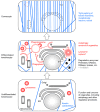Autophagy-Mediated Cellular Remodeling during Terminal Differentiation of Keratinocytes in the Epidermis and Skin Appendages
- PMID: 39451193
- PMCID: PMC11506049
- DOI: 10.3390/cells13201675
Autophagy-Mediated Cellular Remodeling during Terminal Differentiation of Keratinocytes in the Epidermis and Skin Appendages
Abstract
The epidermis of the skin and skin appendages, such as nails, hair and sebaceous glands, depend on a balance of cell proliferation and terminal differentiation in order to fulfill their functions at the interface of the body and the environment. The differentiation of epithelial cells of the skin, commonly referred to as keratinocytes, involves major remodeling processes that generate metabolically inactive cell remnants serving as building blocks of the epidermal stratum corneum, nail plates and hair shafts. Only sebaceous gland differentiation results in cell disintegration and holocrine secretion. A series of studies performed in the past decade have revealed that the lysosome-dependent intracellular degradation mechanism of autophagy is active during keratinocyte differentiation, and the blockade of autophagy significantly alters the properties of the differentiation products. Here, we present a model for the autophagy-mediated degradation of organelles and cytosolic proteins as an important contributor to cellular remodeling in keratinocyte differentiation. The roles of autophagy are discussed in comparison to alternative intracellular degradation mechanisms and in the context of programmed cell death as an integral end point of epithelial differentiation.
Keywords: apoptosis; autophagy; cornification; hair; keratin; keratinocytes; nail; protease; sebaceous; skin barrier.
Conflict of interest statement
The authors declare no conflicts of interest.
Figures




Similar articles
-
Cornification of nail keratinocytes requires autophagy for bulk degradation of intracellular proteins while sparing components of the cytoskeleton.Apoptosis. 2019 Feb;24(1-2):62-73. doi: 10.1007/s10495-018-1505-4. Apoptosis. 2019. PMID: 30552537 Free PMC article.
-
Cell death induced autophagy contributes to terminal differentiation of skin and skin appendages.Autophagy. 2020 May;16(5):932-945. doi: 10.1080/15548627.2019.1646552. Epub 2019 Aug 4. Autophagy. 2020. PMID: 31379249 Free PMC article.
-
Control of cell death-associated danger signals during cornification prevents autoinflammation of the skin.Exp Dermatol. 2018 Aug;27(8):884-891. doi: 10.1111/exd.13700. Exp Dermatol. 2018. PMID: 29862564
-
Cell death by cornification.Biochim Biophys Acta. 2013 Dec;1833(12):3471-3480. doi: 10.1016/j.bbamcr.2013.06.010. Epub 2013 Jun 20. Biochim Biophys Acta. 2013. PMID: 23792051 Review.
-
Cell differentiation in the embryonic periderm and in scaffolding epithelia of skin appendages.Dev Biol. 2024 Nov;515:60-66. doi: 10.1016/j.ydbio.2024.07.002. Epub 2024 Jul 2. Dev Biol. 2024. PMID: 38964706 Review.
Cited by
-
RORA Regulates Autophagy in Hair Follicle Stem Cells by Upregulating the Expression Level of the Sqstm1 Gene.Biomolecules. 2025 Feb 18;15(2):299. doi: 10.3390/biom15020299. Biomolecules. 2025. PMID: 40001602 Free PMC article.
-
Loss of TC-PTP in keratinocytes leads to increased UVB-induced autophagy.Cell Death Discov. 2025 Feb 28;11(1):80. doi: 10.1038/s41420-025-02353-8. Cell Death Discov. 2025. PMID: 40021617 Free PMC article.
-
Skin Appendage Proteins of Tetrapods: Building Blocks of Claws, Feathers, Hair and Other Cornified Epithelial Structures.Animals (Basel). 2025 Feb 6;15(3):457. doi: 10.3390/ani15030457. Animals (Basel). 2025. PMID: 39943227 Free PMC article. Review.
References
Publication types
MeSH terms
LinkOut - more resources
Full Text Sources
Miscellaneous

